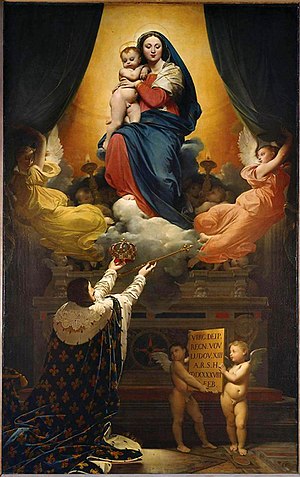| The Vow of Louis XIII | |
|---|---|
| fr: Le Voeu de Louis XIII | |
 | |
| Artist | Jean-Auguste-Dominique Ingres |
| Year | 1824 |
| Catalogue | The Paintings of J. A. D. Ingres (1954) 155; Palissy PM82000254; Salons ID 124570 |
| Medium | Oil on canvas |
| Dimensions | 421 cm × 262 cm (166 in × 103 in) |
| Designation | Classified as historical monument on Oct. 21, 1903 |
| Location | Montauban Cathedral |
| Accession | D.2013.1.1 |
The Vow of Louis XIII is an 1824 oil painting on canvas by the French Neoclassical artist Jean-Auguste-Dominique Ingres, now in Montauban Cathedral. The painting depicts a vow to the Virgin Mary by Louis XIII of France.
It was commissioned by France's Ministry of Interior in August 1820 for the cathedral of Notre-Dame in Montauban.[1][2] The subject of the painting was to be Louis XIII's vow[3] in 1638 to consecrate his kingdom to the Virgin in Her Assumption.[4] When Ingres accepted the commission, he was living in Florence. Although he had experienced success as a portrait painter, his ambition was to establish a reputation in the more prestigious genre of history painting. He went to work with his usual diligence, and spent four years bringing the large canvas to completion.
He traveled to Paris with it in October 1824. It was a critical success at that year's Salon and later established Ingres' reputation as the main representative of classicism, in opposition to the romanticism represented at the same Salon by The Massacre at Chios by Delacroix.[5] Conceived in a Raphaelesque style relatively free of the archaisms for which he had been reproached in the past, it marked Ingres' grand return to the Paris art world after his years in Rome and Florence, and his abandonment of a more daring style.[6] Ingres found himself celebrated throughout France. In January 1825 he was awarded the Cross of the Légion d'honneur by Charles X,[5] and in June 1825 he was elected to the Institut de France.
Numerous life drawings and painted studies for the painting survive. A small oil sketch of the composition is in the Musée Ingres in Montauban.[7] In 1855, Ingres repeated the figures of the Virgin and Child in a watercolor, Virgin and Child Appearing to Sts. Anthony of Padua and Leopold (Cambridge, Fogg Art Museum).[8]
- ^ Tinterow and Conisbee 1999, p. 548.
- ^ Rosenblum 1986, p. 126.
- ^ "Louis XIII Consecrates France to Our Lady of the Assumption". www.mariedenazareth.com. Retrieved 2022-09-08.
- ^ Arikha 1986, pp. 55–56.
- ^ a b Ternois 1980, p. 70.
- ^ Tinterow and Conisbee 1999, p. 273.
- ^ Radius 1968, p. 102.
- ^ Condon et al., pp. 134, 245.